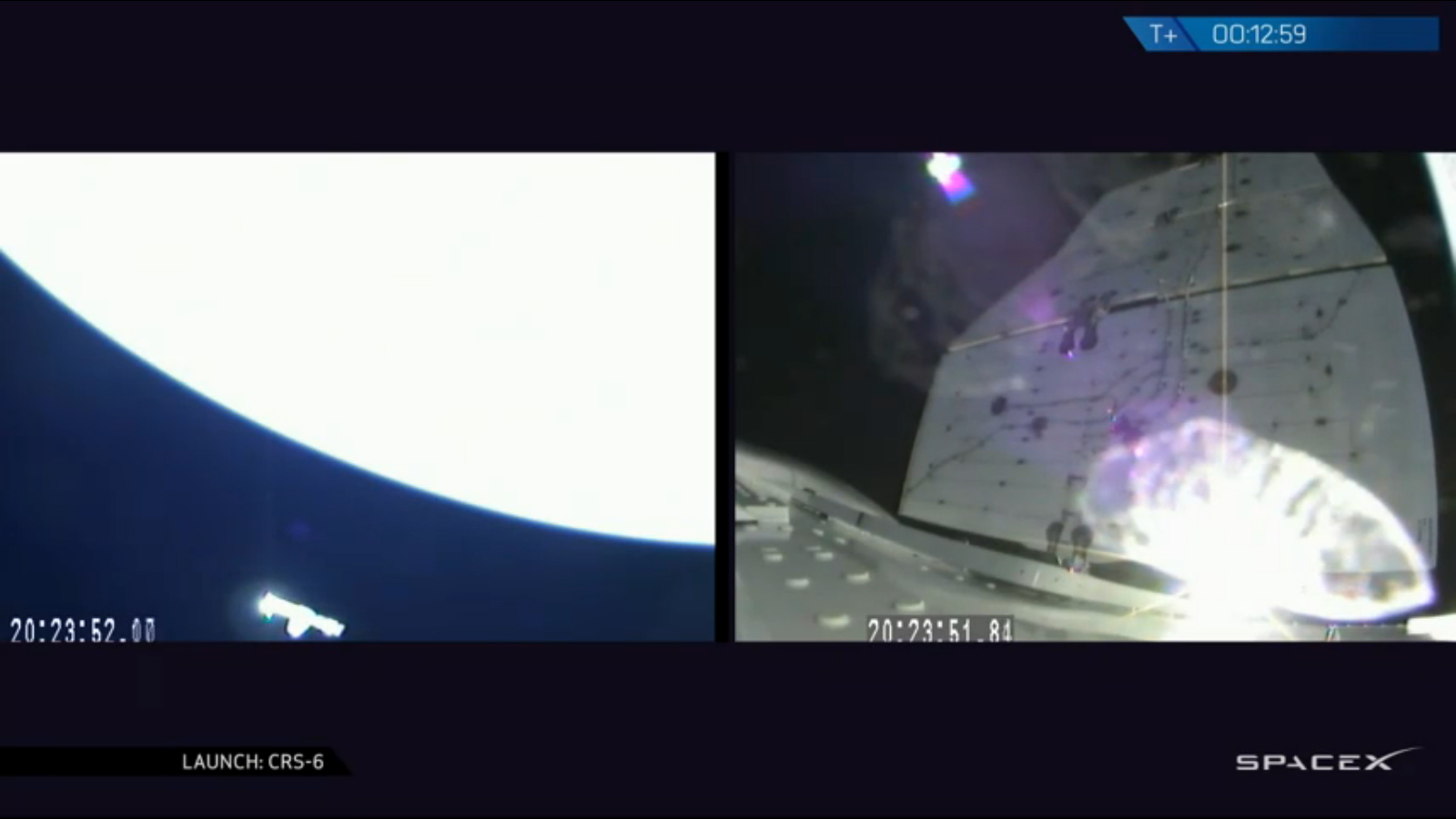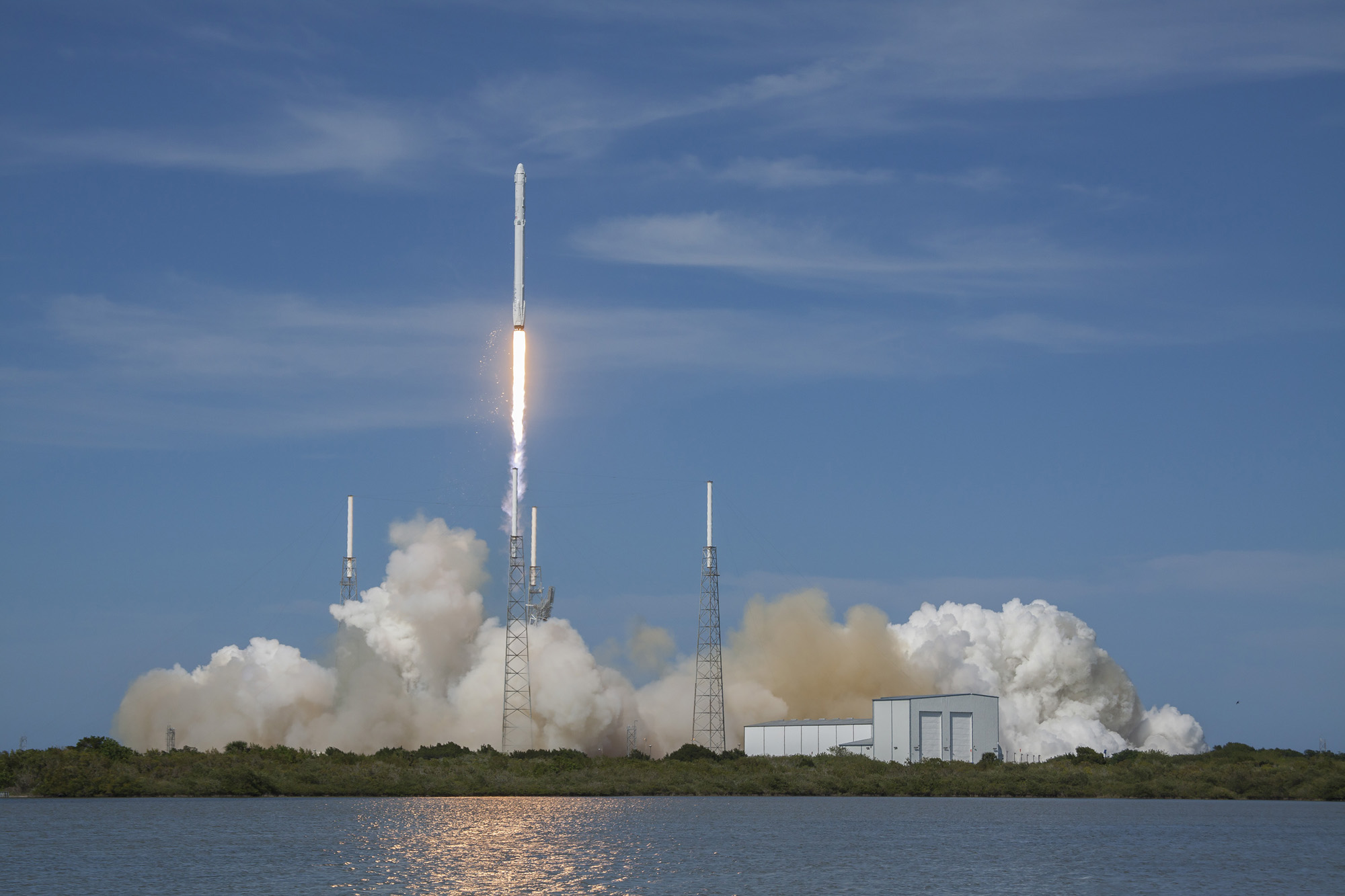SpaceX's Dragon Space Capsule Now Visible in Night Sky: How to See It

Skywatchers across parts of the United States and southern Canada have a chance to see a Dragon capsule built by the private spaceflight company SpaceX "chase" the International Space Station across the sky this week ahead of a Friday morning rendezvous.
SpaceX launched the Dragon cargo ship into orbit on Tuesday (April 14) during its sixth commercial cargo mission for NASA. The spacecraft blasted off at 4:10 p.m. EDT (2016 GMT) from Cape Canaveral Air Force Station in Florida and is carrying more than 2 tons of supplies for the space station's six-person crew.
Weather permitting, both the unmanned Dragon and space station will be visible as separate entities, appearing as "stars" sailing across the evening's twilight sky. Dragon is expected to arrive at the space station on Friday morning (April 17) at around 7 a.m. EDT (1100 MT), meaning that by Friday evening, both will appear as a singular bright moving "star." [Launch Photos: SpaceX's Dragon Soars Into Orbit]
The station makes one full orbit of the Earth every 90 minutes. Initially, SpaceX's Dragon will trail the orbiting outpost by about 25 minutes. But by Thursday evening, that gap will have diminished to only about 1 or 2 minutes. That means it might be possible to see both space vehicles in the sky at the same time. The station would appear first, followed a minute or two later by the Dragon capsule traveling along basically the same path.
How bright will Dragon be?
Most satellites become visible only when they are in sunlight and the observer is in deep twilight or darkness. This usually means they can be spotted shortly after dusk or before dawn. Because of its size and the configuration of highly reflective solar panels, the station is now, by far, the brightest man-made object currently in orbit around Earth.
On favorable passes, the International Space Station is as brilliant as magnitude -5 in brightness, which rivals Venus and is more than 25 times brighter than Sirius, the brightest star in the night sky. Some skywatchers have even caught a glimpse of the station just prior to sunset or shortly after sunrise. And as a bonus, sunlight glinting directly off the solar panels can sometimes make the space laboratory appear to briefly flare to superbrilliance.
Breaking space news, the latest updates on rocket launches, skywatching events and more!
SpaceX's Dragon space capsule, on the other hand, is much smaller than the station, measuring about 14.4 feet (4.4 meters) tall and 12 feet (3.66 m) in diameter. The trunk is about 9.2 feet (2.8 m) tall and 12 feet wide, but with its solar panels fully extended, the vehicle is about 54 feet (16.5 m) wide.
Consequently, in terms of overall brightness, Dragon will appear much dimmer than the station. It may appear roughly as bright as a third-magnitude star (i.e., moderately bright). Megrez, the star that joins the handle with the bowl of the Big Dipper, is a third-magnitude star. That would make the Dragon capsule about 1,500 times dimmer than the space station.
When and where to look
So, what is the viewing schedule for your hometown? There are actually several ways to try and see the station. You can easily find out by visiting one of these three websites:
- Chris Peat's Heavens Above
- NASA's Spot the Station
- Spaceweather.com Satellite Flybys
Each site will ask for your ZIP code or city and return a list of suggested spotting times. Predictions computed a few days ahead of time are usually accurate within a few minutes. However, they can change due to the slow decay of the space station's orbit and periodic reboosts to higher altitudes. So you want check for updates to plan your observing night.
Another great website is n2y0.com, which provides real-time satellite tracking at any given moment.
Editor's note: If you snap a photo of the Dragon space capsule and space station in the night sky and want to share the image with Space.com for a possible story or gallery, send images and comments in to managing editor Tariq Malik at: tmalik@space.com.
SpaceX's Dragon cargo delivery mission is the sixth of at least 12 cargo missions for NASA under a deal initially worth $1.6 billion. In addition to the successful Dragon launch, SpaceX also attempted to land the first stage of its Falcon 9 rocket on a drone ship in the Atlantic Ocean as part of a reusable rocket technology program.
According to SpaceX CEO Elon Musk, the Falcon 9 rocket made it to the drone ship, but tipped over and fell due to excess sideways motion at touchdown. The failed landing try was SpaceX's third of the year, with more expected later in 2015.
Joe Rao serves as an instructor and guest lecturer at New York's Hayden Planetarium. He writes about astronomy for Natural History magazine, the Farmer's Almanac and other publications, and he is also an on-camera meteorologist for News 12 Westchester, N.Y.Follow us @Spacedotcom, Facebook and Google+. Original article on Space.com.

Joe Rao is Space.com's skywatching columnist, as well as a veteran meteorologist and eclipse chaser who also serves as an instructor and guest lecturer at New York's Hayden Planetarium. He writes about astronomy for Natural History magazine, Sky & Telescope and other publications. Joe is an 8-time Emmy-nominated meteorologist who served the Putnam Valley region of New York for over 21 years. You can find him on Twitter and YouTube tracking lunar and solar eclipses, meteor showers and more. To find out Joe's latest project, visit him on Twitter.

